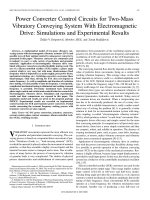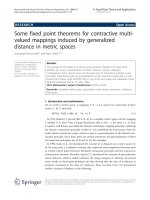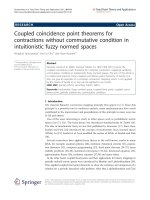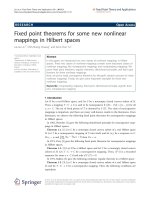SECOND MAIN THEOREMS FOR MEROMORPHIC MAPPINGS INTERSECTING MOVING HYPERPLANES WITH TRUNCATED COUNTING FUNCTIONS AND UNICITY PROBLEM
Bạn đang xem bản rút gọn của tài liệu. Xem và tải ngay bản đầy đủ của tài liệu tại đây (371.38 KB, 18 trang )
SECOND MAIN THEOREMS FOR MEROMORPHIC MAPPINGS
INTERSECTING MOVING HYPERPLANES WITH TRUNCATED
COUNTING FUNCTIONS AND UNICITY PROBLEM
SI DUC QUANG
Abstract. In this article, we show some new second main theorems for the mappings
and moving hyperplanes of Pn (C) with truncated counting functions. Our results are
improvements of recent previous second main theorems for moving hyperplanes with
the truncated (to level n) counting functions. As their application, we prove a unicity
theorem for meromorphic mappings sharing moving hyperplanes.
1. Introduction
The theory of the Nevanlinna’s second main theorem for meromorphic mappings of Cm
into the complex projective space Pn (C) intersecting a finite set of fixed hyperplanes or
moving hyperplanes in Pn (C) was started about 70 years ago and has grown into a huge
theory. For the case of fixed hyperplanes, maybe, the second main theorem given by
Cartan-Nochka is the best possible. Unfortunately, so far there has been a few second
main theorems with truncated counting functions for moving hyperplanes. Moreover,
almost of them are not sharp.
We state here some recent results on the second main theorems for moving hyperplanes
with truncated counting functions.
Let {ai }qi=1 be meromorphic mappings of Cm into the dual space Pn (C)∗ in general
position. For the case of nondegenerate meromorphic mappings, the second main theorem
with truncated (to level n) counting functions states that.
Theorem A (see [4, Theorem 2.3] and [6, Theorem 3.1]). Let f : Cm → Pn (C) be a
meromorphic mapping. Let {ai }qi=1 (q ≥ n + 2) be meromorphic mappings of Cm into
Pn (C)∗ in general position such that f is linearly nondegenerate over R({ai }qi=1 ). Then
q
||
Tf (r) ≤
n+2
q
[n]
N(f,ai ) (r) + o(Tf (r)) + O( max Tai (r)).
1≤i≤q
i=1
We note that, Theorem A is still the best second main theorem with truncated counting
functions for nondegenerate meromorphic mappings and moving hyperplanes available at
present. In the case of degenerate meromorphic mappings, the second main theorem for
moving hyperplanes with counting function truncated to level n was first given by M.
Ru-J. Wang [5] in 2004. After that in 2008, D. D. Thai-S. D. Quang [7] improved the
result of M. Ru-J. Wang by proved the following second main theorem.
2010 Mathematics Subject Classification: Primary 32H30, 32A22; Secondary 30D35.
Key words and phrases: Nevanlinna, second main theorem, meromorphic mapping, moving hyperplane.
Date:
1
2
SI DUC QUANG
Theorem B (see [7, Corollary 1]). Let f : Cm → Pn (C) be a meromorphic mapping. Let
{ai }qi=1 (q ≥ 2n + 1) be q meromorphic mappings of Cm into Pn (C)∗ in general position
such that (f, ai ) ≡ 0 (1 ≤ i ≤ q). Then
q
· Tf (r) ≤
2n + 1
q
[n]
N(f,ai ) (r) + O max Tai (r) +O log+ Tf (r) .
1≤i≤q
i=1
These results play very essential roles in almost all researches on truncated multiplicity
problems of meromorphic mappings with moving hyperplanes. Hovewer, in our opinion,
the above mentioned results of these authors are still weak.
Our main purpose of the present paper is to show a stronger second main theorem of
meromorphic mappings from Cm into Pn (C) for moving targets. Namely, we will prove
the following.
Theorem 1.1. Let f : Cm → Pn (C) be a meromorphic mapping. Let {ai }qi=1 (q ≥
2n − k + 2) be meromorphic mappings of Cm into Pn (C)∗ in general position such that
(f, ai ) ≡ 0 (1 ≤ i ≤ q), where k + 1 = rankR{ai } (f ). Then the following assertions hold:
q
(a) ||
Tf (r) ≤
2n − k + 2
q
[k]
N(f,ai ) (r) + o(Tf (r)) + O( max Tai (r)),
1≤i≤q
i=1
q − n + 2k − 1
Tf (r) ≤
(b) ||
n+k+1
q
[k]
N(f,ai ) (r) + o(Tf (r)) + O( max Tai (r)).
1≤i≤q
i=1
We may see that Theorem 1.1(a) is a generalization of Theorem A and also is an
improvement of Theorem B. Theorem 1.1(b) is really stronger than Theorem B.
Remark.
n+1
1) If k ≥
then Theorem 1.1(a) is stronger than Theorem 1.1(b). Otherwise, if
2
n+1
k<
then Theorem 1.1(b) is stronger than Theorem 1.1(a).
2
2) If k = 0 then f is constant map, and hence Tf (r) = 0.
3) Setting t = 2n−k+2
and λ = n+k+1
, we have t + λ = 1. Thus, for all 1 ≤ k ≤ n we
3n+3
3n+3
have
q
q − n + 2k − 1
q
q − n + 2k − 1
≥
max
,
·t+
·λ
2n − k + 2
n+k+1
2n − k + 2
n+k+1
=
2q − n + 2k − 1
2q − n + 1
≥
.
3n + 3
3n + 3
4) If k ≥ 1, we have the following estimates:
• min n+1 ≤k≤n,(k∈Z)
2
• min1≤k≤ n+1 ,(k∈Z)
2
q
q
2q
≥
=
.
n+1
2n − k + 2
3(n + 1)
2n − 2 + 2
q − n + 2k − 1
q − 3n − 3
= min1≤k≤ n+1 ,(k∈Z)
+2
2
n+k+1
n+k+1
SECOND MAIN THEOREMS FOR MEROMORPHIC MAPPINGS
2q
+ 1)
≥ 3(n
q
−
n+1
n+2
3
if q ≥ 3n + 3
if q < 3n + 3
Thus
2q
if q ≥ 3n + 3
q − n + 2k − 1
q
3(n
+
1)
,
≥ q−n+1
min max
1≤k≤n
2n − k + 2
n+k+1
if q < 3n + 3.
n+2
Therefore, from Theorem 1.1 and Remark (1-4) we have the following corollary.
Corollary 1.2. Let f : Cm → Pn (C) be a meromorphic mapping. Let {ai }qi=1 (q ≥ 2n+1)
be meromorphic mappings of Cm into Pn (C)∗ in general position such that (f, ai ) ≡ 0 (1 ≤
i ≤ q).
(a) Then we have
2q − n + 1
||
Tf (r) ≤
3(n + 1)
q
[n]
N(f,ai ) (r) + o(Tf (r)) + O( max Tai (r)).
1≤i≤q
i=1
(b) If q ≥ 3n + 3 then
2q
||
Tf (r) ≤
3(n + 1)
q
[n]
N(f,ai ) (r) + o(Tf (r)) + O( max Tai (r)).
1≤i≤q
i=1
(c) If q < 3n + 3 then
q−n+1
Tf (r) ≤
||
n+2
q
[n]
N(f,ai ) (r) + o(Tf (r)) + O( max Tai (r)).
i=1
1≤i≤q
As applications of these second main theorems, in the last section we will prove a
unicity theorem for meromorphic mappings sharing moving hyperplanes regardless of
multiplicities. To state our main result, we give the following definition.
Let f : Cm → Pn (C) be a meromorphic mapping. Let k be a positive integer or maybe
+∞. Let {ai }qi=1 be “slowly” (with respect to f ) moving hyperplanes in Pn (C) in general
position such that
dim {z ∈ Cm : (f, ai )(z) · (f, aj )(z) = 0} ≤ m − 2 (1 ≤ i < j ≤ q).
Consider the set F(f, {ai }qi=1 , k) of all meromorphic maps g : Cm → Pn (C) satisfying
the following two conditions:
(a) min{ν(f,ai ) (z), k} = min{ν(g,ai ) (z), k} (1 ≤ i ≤ q), for all z ∈ Cm ,
(b) f (z) = g(z) for all z ∈ qi=1 Zero(f, ai ).
We wil prove the following
Theorem 1.3. Let f : Cm → Pn (C) be a meromorphic mapping. Let {ai }qi=1 be slowly
(with respect to f ) moving hyperplanes in Pn (C) in general position such that
dim {z ∈ Cm : (f, ai )(z) · (f, aj )(z) = 0} ≤ m − 2
(1 ≤ i < j ≤ q).
4
SI DUC QUANG
Then the following assertions hold:
2
then F(f, {ai }qi=1 , 1) ≤ 2,
a) If q > 9n +9n+4
4
b) If q > 3n2 + n + 2 then F(f, {ai }qi=1 , 1) = 1.
Acknowledgements. This work was done during a stay of the author at Vietnam
Institute for Advanced Study in Mathematics. He would like to thank the institute for
their support.
2. Basic notions and auxiliary results from Nevanlinna theory
(a) Counting function of divisor.
For z = (z1 , . . . , zm ) ∈ Cm , we set z =
m
|zj |2
1/2
and define
j=1
B(r) = {z ∈ Cm ; z < r}, S(r) = {z ∈ Cm ; z = r},
√
−1
m−1
c
d =
(∂ − ∂), σ = ddc z 2
,
4π
m−1
η = dc log z 2 ∧ ddc log z
.
Thoughout this paper, we denote by M the set of all meromorphic functions on Cm . A
divisor E on Cm is given by a formal sum E =
µν Xν , where {Xν } is a locally family
of distinct irreducible analytic hypersurfaces in Cm and µν ∈ Z. We define the support of
the divisor E by setting Supp (E) = ∪ν=0 Xν . Sometimes, we identify the divisor E with
a function E(z) from Cm into Z defined by E(z) := Xν z µν .
Let k be a positive integer or +∞. We define the truncated divisor E [k] by
E [k] :=
min{µν , k}Xν ,
ν
and the truncated counting function to level k of E by
r
N [k] (r, E) :=
n[k] (t, E)
dt (1 < r < +∞),
t2m−1
1
where
[k]
n (t, E) :=
E [k] σ
Supp (E)∩B(t)
[k]
|z|≤t E (z)
if m ≥ 2,
if m = 1.
We omit the character [k] if k = +∞.
For an analytic hypersurface E of Cm , we may consider it as a reduced divisor and
denote by N (r, E) its counting function.
Let ϕ be a nonzero meromorphic function on Cm . We denote by νϕ0 (resp. νϕ∞ ) the
divisor of zeros (resp. divisor of poles) of ϕ. The divisor of ϕ is defined by
νϕ = νϕ0 − νϕ∞ .
SECOND MAIN THEOREMS FOR MEROMORPHIC MAPPINGS
5
We have the following Jensen’s formula:
N (r, νϕ0 ) − N (r, νϕ∞ ) =
log|ϕ|η −
S(r)
log|ϕ|η.
S(1)
[k]
For convenience, we will write Nϕ (r) and Nϕ (r) for N (r, νϕ0 ) and N [k] (r, νϕ0 ), respectively.
(b) The first main theorem.
Let f be a meromorphic mapping of Cm into Pn (C). For arbitrary fixed homogeneous
coordinates (w0 : · · · : wn ) of Pn (C), we take a reduced representation f = (f0 : · · · : fn ),
which means that each fi is holomorphic function on Cm and f (z) = (f0 (z) : · · · : fn (z))
outside the analytic set I(f ) := {z; f0 (z) = · · · = fn (z) = 0} of codimension at least 2.
Denote by Ω the Fubini Study form of Pn (C). The characteristic function of f (with
respect to Ω) is defined by
r
dt
Tf (r) :=
f ∗ Ω ∧ σ,
1 < r < +∞.
2m−1
t
1
B(t)
By Jensen’s formula we have
log ||f ||η + O(1),
Tf (r) =
S(r)
where f = max{|f0 |, . . . , |fn |}.
Let a be a meromorphic mapping of Cm into Pn (C)∗ with reduced representation a =
(a0 : · · · : an ). We define
mf,a (r) =
log
||f || · ||a||
η−
|(f, a)|
S(r)
log
||f || · ||a||
η,
|(f, a)|
S(1)
1/2
and (f, a) = ni=0 fi · ai .
where a = |a0 |2 + · · · + |an |2
Let f and a be as above. If (f, a) ≡ 0, then the first main theorem for moving hyperplaness in value distribution theory states
Tf (r) + Ta (r) = mf,a (r) + N(f,a) (r) + O(1) (r > 1).
For a meromorphic function ϕ on Cm , the proximity function m(r, ϕ) is defined by
log+ |ϕ|η,
m(r, ϕ) =
S(r)
+
where log x = max log x, 0 for x
0. The Nevanlinna’s characteristic function is
defined by
T (r, ϕ) = N (r, νϕ∞ ) + m(r, ϕ).
We regard ϕ as a meromorphic mapping of Cm into P1 (C)∗ , there is a fact that
Tϕ (r) = T (r, ϕ) + O(1).
(c) Lemma on logarithmic derivative.
As usual, by the notation “|| P ” we mean the assertion P holds for all r ∈ [0, ∞)
excluding a Borel subset E of the interval [0, ∞) with E dr < ∞. Denote by Z+ the set
6
SI DUC QUANG
of all nonnegative integers. The lemma on logarithmic derivative in Nevanlinna theorey
is stated as follows.
Lemma 2.1 (see [8, Lemma 3.11]). Let f be a nonzero meromorphic function on Cm .
Then
Dα (f )
= O(log+ Tf (r)) (α ∈ Zm
m r,
+ ).
f
(d) Family of moving hyperplanes.
We assume that thoughout this paper, the homogeneous coordinates of Pn (C) is chosen
so that for each given meromorphic mapping a = (a0 : · · · : an ) of Cm into Pn (C)∗ then
a0 ≡ 0. We set
ai
a
˜i =
and a
˜ = (˜
a0 : a
˜1 : · · · : a
˜n ).
a0
Let f : Cm → Pn (C) be a meromorphic mapping with the reduced representation f =
(f0 : · · · : fn ). We put (f, a) := ni=0 fi ai and (f, a
˜) := ni=0 fi a
˜i .
q
Let {ai }i=1 be q meromorphic mappings of Cm into Pn (C)∗ with reduced representations
ai = (ai0 : · · · : ain ) (1 ≤ i ≤ q). We denote by R({ai }) (for brevity we will write R if
there is no confusion) the smallest subfield of M which contains C and all aij /aik with
aik ≡ 0.
Definition 2.2. The family {ai }qi=1 is said to be in general position if dim({ai0 , . . . , ain })M =
n + 1 for any 1 ≤ i0 ≤ · · · ≤ in ≤ q, where ({ai0 , . . . , ain })M is the linear span of
{ai0 , . . . , aiN } over the field M.
Definition 2.3. A subset L of M (or Mn+1 ) is said to be minimal over the field R if it
is linearly dependent over R and each proper subset of L is linearly independent over R.
Repeating the argument in ([1, Proposition 4.5]), we have the following:
Proposition 2.4 (see [1, Proposition 4.5]). Let Φ0 , . . . , Φk be meromorphic functions
on Cm such that {Φ0 , . . . , Φk } are linearly independent over C. Then there exists an
n
admissible set {αi = (αi1 , . . . , αim )}ki=0 ⊂ Zm
+ with |αi | =
j=1 |αij | ≤ k (0 ≤ i ≤ k) such
that the following are satisfied:
(i) {Dαi Φ0 , . . . , Dαi Φk }ki=0 is linearly independent over M, i.e, det (Dαi Φj ) ≡ 0.
(ii) det Dαi (hΦj ) = hk+1 det Dαi Φj for any nonzero meromorphic function h on Cm .
3. Proof of Theorem 1.1
In order to prove Theorem 1.1 we need the following.
Lemma 3.1. Let f : Cm → Pn (C) be a meromorphic mapping. Let {ai }qi=1 (q ≥ n + 1)
be q meromorphic mappings of Cm into Pn (C)∗ in general position. Assume that there
exists a partition {1, . . . , q} = I1 ∪ I2 · · · ∪ Il satisfying:
(i) {(f, a
˜i )}i∈I1 is minimal over R, and {(f, a
˜i )}i∈It is linearly independent over R (2 ≤
t ≤ l),
SECOND MAIN THEOREMS FOR MEROMORPHIC MAPPINGS
7
(ii) For any 2 ≤ t ≤ l, i ∈ It , there exist meromorphic functions ci ∈ R \ {0} such that
t−1
ci (f, a
˜i ) ∈
(f, a
˜i )
j=1 i∈Ij
i∈It
.
R
Then we have
q
[k]
Tf (r) ≤
N(f,ai ) + o(Tf (r)) + O( max Tai (r)),
1≤i≤q
i=1
where k + 1 = rankR (f ).
Proof. Let f = (f0 : · · · : fn ) be a reduced representation of f . By changing the
homogeneous coordinate system of Pn (C) if necessary, we may assume that f0 ≡ 0.
Without loss of generality, we may assume that I1 = {1, . . . ., k1 } and
It = {kt−1 + 1, . . . , kt } (2 ≤ t ≤ l), where 1 = k0 < · · · < kl = q.
Since {(f, a
˜i )}i∈I1 is minimal over R, there exist c1i ∈ R \ {0} such that
k1
c1i · (f, a
˜i ) = 0.
i=1
Define c1i = 0 for all i > k1 . Then
kl
c1i · (f, a
˜i ) = 0.
i=1
1
Because {c1i (f, a
˜i )}ki=k
is linearly independent over R, Lemma 2.4 yields that there
0 +1
exists an admissible set {α1(k0 +1) , . . . , α1k1 } ⊂ Zm
+ (|α1i | ≤ k1 − k0 − 1 ≤ rankR f − 1 = k)
such that the matrix
A1 = (Dα1i (c1j (f, a
˜j )); k0 + 1 ≤ i, j ≤ k1 )
has nonzero determinant.
Now consider t ≥ 2. By constructing the set It , there exist meromorphic mappings
cti ≡ 0 (kt−1 + 1 ≤ i ≤ kt ) such that
t−1
kt
cti · (f, a
˜i ) ∈
(f, a
˜i )
j=1 i∈It
i=kt−1 +1
.
R
Therefore, there exist meromorphic mappings cti ∈ R (1 ≤ i ≤ kt−1 ) such that
kt
cti · (f, a
˜i ) = 0.
i=1
Define cti = 0 for all i > kt . Then
kl
cti · (f, a
˜i ) = 0.
i=1
8
SI DUC QUANG
t
is R-linearly independent, by again Lemma 2.4 there exists an
Since {cti (f, a
˜i )}ki=k
t−1 +1
admissible set {αt(kt−1 +1) , . . . , αtkt } ⊂ Zm
+ (|αti | ≤ kt − kt−1 − 1 ≤ rankR f − 1 = k) such
that the matrix
At = (Dαti (c1j (f, a
˜j )); kt−1 + 1 ≤ i, j ≤ kt )
has nonzero determinant.
Consider the following (kl − 1) × kl matrix
T = (Dαti (c1j (f, a
˜j )); k0 + 1 ≤ i ≤ kt , 1 ≤ j ≤ kt )
Dα12 (c11 (f, a
˜1 ))
Dα13 (c11 (f, a
˜1 ))
..
.
···
···
..
.
Dα12 (c1kl (f, a
˜kl ))
Dα13 (c1kl (f, a
˜kl ))
..
.
Dα1k1 (c11 (f, a
˜1 ))
Dα2k1 +1 (c21 (f, a
˜1 ))
α2k1 +2
D
(c21 (f, a
˜1 ))
..
.
α2k2
D
(c21 (f, a
˜1 ))
..
.
Dαlkl−1 +1 (cl1 (f, a
˜1 ))
αlkl−1 +2
D
(cl1 (f, a
˜1 ))
..
.
···
···
···
..
.
···
..
.
···
···
..
.
Dα1k1 (c1kl (f, a
˜kl ))
Dα2k1 +1 (c2kl (f, a
˜kl ))
α2k1 +2
D
(c2kl (f, a
˜kl ))
..
.
α2k2
˜kl ))
D
(c2kt (f, a
..
.
˜kl ))
Dαlkl−1 +1 (clkl (f, a
αlkl−1 +2
D
(clkl (f, a
˜kl ))
..
.
˜1 ))
Dαlkl (clk (f, a
···
˜kl ))
Dαlkl (clkl (f, a
=
.
Denote by Di the subsquare matrix obtained by deleting the (i + 1)-th column of the
minor matrix T . Since the sum of each row of T is zero, we have
l
det Di = (−1)i−1 det D1 = (−1)i−1
det Aj .
j=1
Since {ai }qi=1 is in general position, we have
det(˜
aij , 1 ≤ i ≤ n + 1, 0 ≤ j ≤ n) ≡ 0.
By solving the linear equation system (f, a
˜i ) = a
˜i0 · f0 + . . . + a
˜in · fn (1 ≤ i ≤ n + 1), we
obtain
n+1
(3.2)
Avi (f, a
˜i ) (Avi ∈ R) for each 0 ≤ v ≤ n.
fv =
i=1
Put Ψ(z) =
n+1
i=1
n
v=0
|Avi (z)| (z ∈ Cm ). Then
||f (z)|| ≤ Ψ(z) · max
1≤i≤n+1
|(f, a
˜i )(z)| ≤ Ψ(z) · max |(f, a
˜i )(z)| (z ∈ Cm ),
1≤i≤q
SECOND MAIN THEOREMS FOR MEROMORPHIC MAPPINGS
and
n+1
n
+
log+ |Avi (z)|η + O(1)
log Ψ(z)η ≤
i=1 v=0
S(r)
n+1
S(r)
n
≤
T (r, Avi ) + O(1)
i=1 v=0
= O( max Tai (r)) + O(1).
1≤i≤q
Fix z0 ∈ Cm \
q
j=1
∞
0
Supp (ν(f,˜
aj ) ) . Take i (1 ≤ i ≤ q) such that
aj ) ) ∪ Supp (ν(f,˜
|(f, a
˜i )(z0 )| = max (|f, a
˜j )(z0 )|.
1≤j≤q
Then
| det D1 (z0 )| · ||f (z0 )||
=
q
˜i )(z0 )|
j=1 |(f, a
| det Di (z0 )|
·
|(f, a
˜j )(z0 )|
q
j=0
||f (z0 )||
|(f, a
˜i )(z0 )|
j=i
≤ Ψ(z0 ) ·
| det Di (z0 )|
.
|(f, a
˜j )(z0 )|
q
j=1
j=i
This implies that
log
| det D1 (z0 )|.||f (z0 )||
≤ log+ Ψ(z0 ) ·
q
|(f,
a
˜
)(z
)|
j
0
j=1
| det Di (z0 )|
+ log+ Ψ(z0 ).
|(f, a
˜j )(z0 )|
≤ log+
Thus, for each z ∈ Cm \
q
j=1
| det Di (z0 )|
|(f, a
˜j )(z0 )|
q
j=1,j=i
q
j=1,j=i
0
∞
Supp (ν(f,˜
aj ) ) ∪ Supp (ν(f,˜
aj ) ) , we have
| det D1 (z)|.||f (z)||
log
≤
q
˜i )(z)|
i=1 |(f, a
q
| det Di (z)|
+ log+ Ψ(z)
|(f, a
˜j )(z)|
log+
q
j=1,j=i
i=1
Hence
(3.3)
log ||f (z)|| + log
| det D1 (z)|
≤
q
˜i )(z)|
i=1 |(f, a
q
log+
i=1
| det Di (z)|
+ log+ Ψ(z).
|(f, a
˜j )(z)|
q
j=1,j=i
9
10
SI DUC QUANG
Note that
det Di /f0q−1
det Di
=
q
˜j )
j=1,j=i (f, a
q
j=1,j=i
α12
D
=
αlk
D l
(f, a
˜j )/f0
c11 (f, a
˜1 )
f0
(f, a
˜1 )
f0
..
.
cl1 (f, a
˜1 )
f0
(f, a
˜1 )
f0
D
α12
···
..
.
Dαlkl
···
c1kl (f, a
˜kl )
f0
(f, a
˜kl )
f0
..
.
˜kl )
clkl (f, a
f0
(f, a
˜kl )
f0
(The determinant is counted after deleting the i-th column in the above matrix).
Each element of the above matrix has a form
Dα
c(f, a
˜j )
f0
(f, a
˜j )
f0
Dα
=
c(f, a
˜j )
f0
c(f, a
˜j )
f0
· c (c ∈ R).
By lemma on logarithmic derivative lemma, we have
Dα
m r,
c(f, a
˜j )
f0
(f, a
˜j )
f0
c(f, a
˜j )
f0
≤ m r,
+m(r, c)
c(f, a
˜j )
f0
c(f, a
˜j )
= O log+ T r,
+O( max T (r, ai ))
1≤i≤q
f0
+
= O(log Tf (r)) + O( max T (r, ai )).
Dα
1≤i≤q
This yields that
det Di
q
˜j )
j=1,j=i (f, a
m r,
= O(log+ Tf (r)) + O( max Taj (r)) (1 ≤ i ≤ q).
1≤j≤q
Hence
q
m r,
i=1
det Di
q
˜j )
j=1,j=i (f, a
= O(log+ Tf (r)) + O( max Taj (r)).
1≤j≤q
SECOND MAIN THEOREMS FOR MEROMORPHIC MAPPINGS
11
Integrating both sides of the inequality (3.3), we have
log ||f ||η +
S(r)
| det D0 |
η
|(f, a
˜i )|
log
q
i=1
S(r)
q
log+
≤
S(r)
i=1
q
det Di
q
˜j )
j=1,j=i (f, a
m r,
=
| det Di |
η+
|(f, a
˜j )|
q
j=1,j=i
i=1
log+ Ψ(z)η
S(r)
+O( max Tai (r))
1≤i≤q
= O(log+ Tf (r)) + O( max Tai (r)).
0≤i≤q−1
Hence
|| Tf (r) +
log
S(r)
|| Tf (r) =
| det D1 |
η = O(log+ Tf (r)) + O( max Tai (r)), i.e,
1≤i≤q
|(f, a
˜i )|
q
i=1
q
i=1
|(f, a
˜i )|
η + O(log+ Tf (r)) + O( max Tai (r))
1≤i≤q
| det D1 |
log
S(r)
q
=
i=1
S(r)
(3.4)
≤N
q
ai )
i=1 (f,˜
Claim 3.5. || N
log| det D1 |η + O(log+ Tf (r)) + O( max Tai (r))
|(f, a
˜i )|η −
log
1≤i≤q
S(r)
(r) − N (r, νdet D1 ) + O(log+ Tf (r)) + O( max Tai (r)).
1≤i≤q
q
ai )
i=1 (f,˜
(r) − N (r, νdet D1 ) ≤
q
i=1
[k]
N(f,ai ) (r) + O(max1≤i≤q Tai (r)).
Indeed, fix z ∈ Cm \ I(f ), where I(f ) = {f0 = · · · fn = 0}. We call i0 the index
satisfying
0
0
ν(f,˜
ai0 ) (z) = min ν(f,˜
ai ) (z).
1≤i≤n+1
For each i = i0 , i ∈ Is , we have
νD0 αsks−1 +j (c
ai ))
si (f,˜
(z) ≥
≥
min
m
β∈Zm
+ with αsks−1 +j −β∈Z+
min
n
β∈Zn
+ with αsks−1 +j −β∈Z+
{ν 0 β
D csi D
αst
−β
s−1 +j
(f,˜
ai )
(z)}
0
max{0, ν(f,˜
ai ) (z) − |αsks−1 +j − β|}
− (β + 1)νc∞si (z)
0
∞
≥ max{0, ν(f
a
˜i ) (z) − k} − (k + 1)νcsi (z)
On the other hand, we also have
νD∞αsks−1 +j (c
ai ))
si (f,˜
(z) ≤ (|αsks−1 +j | + 1)νc∞si (f,˜ai ) (z) ≤ (k + 1)(νc∞si (z) + νa0i0 (z)).
Thus
0
∞
0
νDαsks−1 +j (csi (f,˜ai )) (z) ≥ max{0, ν(f
a
˜i ) (z) − k} − (k + 1) 2νcsi (z) + νai0 (z)
12
SI DUC QUANG
˜i )) (i = i0 ), one estimates
Since each element of the matrix Di0 has a form Dαsks−1 +j (csi (f, a
∞
0
0
max{0, ν(f
a
˜i ) (z) − k} − (k + 1) 2νcsi (z) + νai0 (z)
νD1 (z) = νDi0 (z) ≥
(3.6)
.
i=i0
We see that there exists v0 ∈ {0, . . . , n} with fv0 (z) = 0. Then by (3.2), there exists
i1 ∈ {1, . . . , n + 1} such that Av0 i1 (z) · (f, a
˜i1 )(z) = 0. Thus
0
∞
0
ν(f,˜
ai0 ) (z) ≤ ν(f,˜
ai1 ) (z) ≤ νAv0 i1 (z) ≤
(3.7)
νA∞vi (z).
Avi ≡0
Combining the inequalities (3.6) and (3.7), we have
ν0 q
ai )
i=1 (f,˜
(z) − νdet D1 (z)
∞
0
0
min{ν(f,˜
ai ) (z), k} + (k + 1) 2νcsi (z) + νai0 (z)
≤
νA∞vi (z)
+
Avi ≡0
i=i0
q
0
∞
0
min{ν(f,˜
ai ) (z), k} + (k + 1) 2νcsi (z) + νai0 (z)
≤
νA∞vi (z),
+
Avi ≡0
i=1
where the index s of csi is taken so that i ∈ Is . Integrating both sides of this inequality,
we obtain
|| N
q
ai )
i=1 (f,˜
(r) − N (r, νdet D1 )
q
[k]
≤
N(f,˜ai ) (r) + (k + 1) 2N
i=1
1
csi
(r) + Nai0 (r)
+
N1/Avi (r)
Avi ≡0
q
(3.8)
[k]
N(f,ai ) (r) + O( max Tai (r)).
=
1≤i≤q
i=1
The claim is proved.
From the inequalities (3.4) and the claim, we get
q
[k]
N(f,ai ) (r) + O(log+ Tf (r)) + O( max Tai (r)).
|| Tf (r) ≤
1≤i≤q
i=1
The lemma is proved.
Proof of Theorem 1.1.
(a). We denote by I the set of all permutations of q−tuple (1, . . . , q). For each element
I = (i1 , . . . , iq ) ∈ I, we set
[k]
[k]
NI = {r ∈ R+ ; N(f,ai ) (r) ≤ · · · ≤ N(f,ai ) (r)}.
1
q
We now consider an element I = (i1 , . . . , iq ) of I. We will construct subsets It of the
set A1 = {1, . . . , 2n − k + 2} as follows.
We choose a subset I1 of A which is the minimal subset of A satisfying that {(f, a
˜ij )}j∈I1
is minimal over R. If I1 ≥ n + 1 then we stop the process.
Otherwise, set A2 = A1 \ I1 . We consider the following two cases:
SECOND MAIN THEOREMS FOR MEROMORPHIC MAPPINGS
13
• Case 1. Suppose that A2 ≥ n + 1. Since {˜
aij }j∈A2 is in general position, we have
(f, a
˜ij ); j ∈ A2
R
= (f0 , . . . , fn )R ⊃ (f, a
˜ij ); j ∈ I1
≡ 0.
R
• Case 2. Suppose that A2 < n + 1. Then we have the following:
dimR (f, a
˜ij ); j ∈ I1
R
dimR (f, a
˜ij ); j ∈ A2
R
≥ k + 1 − (n + 1 − I1 ) = k − n + I1 ,
≥ k + 1 − (n + 1 − A2 ) = k − n + A2 .
We note that I1 + A2 = 2n − k + 2. Hence the above inequalities imply that
dimR
(f, a
˜ij ); j ∈ I1
R
∩ (f, a
˜ij ); j ∈ A2
≥ dimR (f, a
˜ij ); j ∈ I1
R
R
+ dimR (f, a
˜ij ); j ∈ A2
R
− (k + 1)
= k − n + I1 + k − n + A2 − (k + 1) = 1.
Therefore, from the above two case, we see that
(f, a
˜ij ); j ∈ I1
R
∩ (f, a
˜ij ); j ∈ A2
R
= {0}.
Therefore, we may chose a subset I2 ⊂ A2 which is the minimal subset of A2 satisfying
that there exist nonzero meromorphic functions ci ∈ R (i ∈ I2 ),
ci (f, a
˜i ) ∈
i∈I2
.
(f, a
˜i )
R
i∈I1
By the minimality of the set I2 , the family {(f, a
˜ij )}j∈I2 is linearly independent over R,
and hence I2 ≤ k + 1 and
(I2 ∪ I2 ) ≤ min{2n − k + 2, n + k + 1}.
If (I2 ∪ I2 ) ≥ n + 1 then we stop the process.
Otherwise, by repeating the above argument, we have a subset I3 of A3 = A1 \ (I1 ∪ I2 ),
which satisfies the following:
• there exist nonzero meromorphic functions ci ∈ R (i ∈ I3 ) so that
ci (f, a
˜i ) ∈
i∈I3
(f, a
˜i )
,
R
i∈I1 ∪I2
• {(f, a
˜ij )}j∈I3 is linearly independent over R,
• I3 ≤ k + 1 and (I1 ∪ · · · ∪ I3 ) ≤ min{2n − k + 2, n + k + 1}.
Continuing this process, we get the subsets I1 , . . . , Il , which satisfy:
• {(f, a
˜ij )}j∈I1 is minimal over R, {(f, a
˜ij )}j∈It is linearly independent over R (2 ≤
t ≤ l),
• for any 2 ≤ t ≤ l, j ∈ It , there exist meromorphic functions cj ∈ R \ {0} such
that
t−1
cj (f, a
˜ ij ) ∈
j∈It
(f, a
˜ ij )
s=1 j∈Is
,
R
• n + 1 ≤ (I1 ∪ · · · ∪ Il ) ≤ min{2n − k + 2, n + k + 1}.
14
SI DUC QUANG
Then the family of subsets I1 , . . . , It satisfies the assumptions of the Lemma 3.1. Therefore, we have
[k]
|| Tf (r) ≤
N(f,ai ) + o(Tf (r)) + O( max Tai (r)),
1≤i≤q
j
j∈J
where J = I1 ∪ · · · ∪ Il . Then for all r ∈ NI (may be outside a finite Borel measure subset
of R+ ) we have
J
|| Tf (r) ≤
q − (2n − k + 2) + J
(3.9)
q
[k]
N(f,ai ) (r)
j
[k]
+
N(f,ai ) (r)
j
j∈J
j=2n−k+3
+ o(Tf (r)) + O( max Tai (r)).
1≤i≤q
Since J ≤ 2n − k + 2, the above inequality implies that
(3.10)
2n − k + 2
|| Tf (r) ≤
q
We see that
This yields that
I∈I
q
[k]
N(f,ai ) (r) + o(Tf (r)) + O( max Tai (r)),
1≤i≤q
i=1
r ∈ NI .
NI = R+ and the inequality (3.10) holds for every r ∈ NI , I ∈ I.
2n − k + 2
Tf (r) ≤
q
q
[k]
N(f,ai ) (r) + o(Tf (r)) + O( max Tai (r))
1≤i≤q
i=1
for all r outside a finite Borel measure subset of R+ . Thus
q
||
Tf (r) ≤
2n − k + 2
q
[k]
N(f,ai ) (r) + o(Tf (r)) + O( max Tai (r)).
1≤i≤q
i=1
The assertion (a) is proved.
(b) We repeat the same argument as in the proof of the assertion (a). If n + k + 1 >
2n − k + 1 then the assertion (b) is a consequence of the assertion (a). Then we now only
consider the case where n + k + 1 ≤ 2n − k + 1.
From (3.9) with a note that J ≤ n + k + 2, we have
n+k+1
|| Tf (r) ≤
q − (2n − k + 2) + n + k + 1)
n+k+1
=
q − n + 2k − 1
q
[k]
N(f,ai ) (r) + o(Tf (r)) + O( max Tai (r))
1≤i≤q
i=1
q
[k]
N(f,ai ) (r) + o(Tf (r)) + O( max Tai (r)) r ∈ NI .
i=1
1≤i≤q
Repeating again the argument in the proof of assertion (a), we see that the above inequality holds for all r ∈ R+ outside a finite Borel measure set. Then the assertion (b) is
proved.
4. Proof of Theorem 1.3
In order to prove Theorem 1.3, we need the following.
SECOND MAIN THEOREMS FOR MEROMORPHIC MAPPINGS
15
4.1. Let f : Cm → Pn (C) be a meromorphic mapping with a reduced representation
f = (f0 : . . . : fn ). Let {ai }qi=1 be “slowly” (with respect to f ) moving hyperplanes of
Pn (C) in general position such that
dim{z ∈ Cm : (f, ai )(z) = (f, aj )(z) = 0} ≤ m − 2 (1 ≤ i < j ≤ q).
For M + 1 elements f 0 , . . . , f M ∈ F(f, {aj }qj=1 , 1), we put
M
T (r, f k ).
T (r) =
k=0
Assume that ai has a reduced representation ai = (ai0 : · · · : ain ). By changing the
homogeneous coordinate system of Pn (C), we may assume that ai0 ≡ 0 (1 ≤ i ≤ q).
(f k , aj )
We set Fijk := k
(1 ≤ i, j ≤ q, 0 ≤ k ≤ M ).
(f , ai )
Lemma 4.1. Suppose that q ≥ 2n + 1. Then
|| Tg (r) = O(Tf (r)) for each g ∈ F(f, {ai }qi=1 , 1).
Proof. By Corollary 1.2(a), we have
2q − n + 1
Tg (r) ≤
3(n + 1)
q
[n]
N(g,ai ) (r) + o(Tg (r) + Tf (r))
i=1
q
[1]
≤n
N(g,ai ) (r) + o(Tg (r) + Tf (r))
i=1
q
[1]
=
nN(f,ai ) (r) + o(Tg (r) + Tf (r))
i=1
≤ qnTf (r) + o(Tg (r) + Tf (r)).
Hence
|| Tg (r) = O(Tf (r)).
Definition 4.2 (see [2, p. 138]). Let F0 , . . . , FM be nonzero meromorphic functions on
Cm , where M ≥ 1. Take a set α := (α0 , . . . , αM −1 ) whose components αk are composed
of m nonnegative integers, and set |α| = |α0 | + . . . + |αM −1 |. We define Cartan’s auxiliary
function by
1
D ( F10 )
..
.
α0
Φα ≡ Φα (F0 , . . . , FM ) := F0 F1 · · · FM
Dα
M −1
1
D ( F11 )
..
.
( F10 ) Dα
α0
M −1
···
···
..
.
( F11 ) · · ·
1
D ( F1M )
..
.
α0
Dα
M −1
( F1M )
Lemma 4.3 (see [2, Proposition 3.4]). If Φα (F, G, H) = 0 and Φα ( F1 , G1 , H1 ) = 0 for all α
with |α| ≤ 1, then one of the following assertions holds :
(i) F = G, G = H or H = F
F G
(ii) G
, H and H
are all constant.
F
16
SI DUC QUANG
Lemma 4.4 (see [6, Lemma 4.7]). Suppose that there exists Φα = Φα (Fij00 0 , . . . , Fij00 M ) ≡ 0
M (M − 1)
with 1 ≤ i0 , j0 ≤ q, |α| ≤
, d ≥ |α|. Assume that α is a minimal element such
2
that Φα (Fij00 0 , . . . , Fij00 M ) ≡ 0. Then, for each 0 ≤ k ≤ M , the following holds:
[d−|α|]
[1]
[1]
N(f k ,aj ) (r) ≤ NΦα (r) ≤ T (r) − M · N(f k ,ai ) (r) + o(T (r)).
N(f k ,aj ) (r) + M
0
0
j=j0 ,i0
And hence
[d−|α|]
[1]
|| N(f k ,aj ) (r) + M
N(f k ,aj ) (r) ≤ T (r) + o(T (r)).
0
j=j0
4.2. Proof of Theorem 1.3
2
a) Assume that q > 9n +9n+2
. Suppose that there exist three distinct elements f 0 , f 1 , f 2 ∈
2
q
F(f, {aj }j=1 , 1).
Suppose that there exist two indices i, j ∈ {1, . . . , q} and α = (α0 , α1 ) ∈ (Zn+ )2 with
|α| ≤ 1 such that Φα (Fji0 , Fji1 , Fji2 ) ≡ 0. By Lemma 4.4, we have
[1]
N(f 0 ,at ) (r) ≤ T (r) + o(Tf (r)).
2
t=i
Hence, by Corollary 1.2(b) we have
2
T (r) ≥
3
≥
3
[1]
N(f k ,at ) (r)
k=1 t=i
2
+ o(Tf (r)) ≥
3n
3
[n]
N(f k ,at ) (r) + o(Tf (r))
k=1 t=i
4(q − 1)
T (r) + o(Tf (r)).
9n(n + 1)
Letting r −→ +∞, we get 1 ≥
4(q−1)
,
9n(n+1)
i.e., q ≤
9n2 +9n+4
.
4
This is a contradiction.
Then for two indices i, j (1 ≤ i < j ≤ q), we have
Φα (Fji0 , Fji1 , Fji2 ) ≡ 0 and Φα (Fij0 , Fij1 , Fij2 ) ≡ 0
for all α = (α0 , α1 ) with |α| ≤ 1. By Lemma 4.3, there exists a constant λ such that
Fji0 = λFji1 , Fji1 = λFji2 , or Fji2 = λFji0 .
For instance, we assume that Fji0 = λFji1 . We will show that λ = 1.
Indeed, assume that λ = 1. Since Fji0 = Fji1 on the set k=j {z : (f, ak )(z) = 0}, we
have that Fji0 = Fji1 = 0 on the set k=j {z : (f, ak )(z) = 0}. Hence k=j {z : (f, ak )(z) =
0} ⊂ {z : (f, ai )(z) = 0}. It follows that {z : (f, ak )(z) = 0} = ∅ (k = i, j). We obtain
that
2(q − 2)
[n]
Tf (r) ≤
N(f,ak ) (r) + o(Tf (r)) = o(Tf (r)).
3(n + 1)
k=i,k=j
This is a contradiction. Thus λ = 1 (1 ≤ i < j ≤ q).
Define
I1 = {i ∈ {1, . . . , q − 1} : Fqi0 = Fqi1 },
I2 = {i ∈ {1, . . . , q − 1} : Fqi1 = Fqi2 },
SECOND MAIN THEOREMS FOR MEROMORPHIC MAPPINGS
17
I3 = {i ∈ {1, . . . , q − 1} : Fqi2 = Fqi0 }.
Since (I1 ∪ I2 ∪ I3 ) = {1, . . . , q − 1} = q − 1 ≥ 3n − 2, there exists 1 ≤ k ≤ 3 such that
Ik ≥ n. Without loss of generality, we may assume that I1 ≥ n. This implies that
0
f = f 1 . This is a contradiction.
Thus, we have F(f, {ai }qi=1 , 1) ≤ 2.
b) Assume that q > 3n2 + n + 2.
Take g ∈ F(f, {ai }qi=1 , 1). Suppose that f = g. By changing indices if necessary, we may
assume that
(f, a1 )
(f, a2 )
(f, ak1 )
(f, ak1 +1 )
(f, ak2 )
≡
≡ ··· ≡
≡
≡ ··· ≡
(g, a1 )
(g, a2 )
(g, ak1 )
(g, ak1 +1 )
(g, ak2 )
group 1
≡
group 2
(f, aks−1 +1 )
(f, ak3 )
(f, aks )
(f, ak2 +1 )
≡ ··· ≡
≡ ··· ≡
≡ ··· ≡
,
(g, ak2 +1 )
(g, ak3 )
(g, aks−1 +1 )
(g, aks )
group 3
group s
where ks = q.
For each 1 ≤ i ≤ q, we set
i+n
i+n−q
σ(i) =
if i + n ≤ q,
if i + n > q
and
Pi = (f, ai )(g, aσ(i) ) − (g, ai )(f, aσ(i) ).
By supposition that f = g, the number of elements of each group is at most n. Hence
(f, aσ(i) )
(f, ai )
and
belong to distinct groups. This means that Pi ≡ 0 (1 ≤ i ≤ q).
(g, ai )
(g, aσ(i) )
Fix an index i with 1 ≤ i ≤ q. It is easy to see that
q
[1]
νPi (z) ≥ min{ν(f,ai ) , ν(g,ai ) } + min{ν(f,aσ(i) ) , ν(g,aσ(i) ) } +
ν(f,av ) (z)
v=1
v=i,σ(i)
outside a finite union of analytic sets of dimension ≤ m − 2. Since min{a, b} + n ≥
min{a, n} + min{b, n} for all positive integers a and b, the above inequality implies that
q
[n]
N(f,av ) (r)
NPi (r) ≥
+
[n]
N(g,av ) (r)
−
[1]
nN(f,av ) (r)
[1]
+
N(f,av ) (r).
v=1
v=i,σ(i)
v=i,σ(i)
On the other hand, by the Jensen formula, we have
log |Pi |η + O(1)
NPi (r) =
S(r)
1
1
log(|(f, ai )|2 + |(f, aσ(i) |2 ) 2 η +
≤
S(r)
≤Tf (r) + Tg (r) + o(Tf (r)).
log(|(g, ai )|2 + |(g, aσ(i) |2 ) 2 η + O(1)
S(r)
18
SI DUC QUANG
This implies that
[n]
Tf (r) + Tg (r) ≥
[n]
[1]
N(f,av ) (r) + N(g,av ) (r) − nN(f,av ) (r)
v=i,σ(i)
q
[1]
N(f,av ) (r) + o(Tf (r)).
+
v=1
v=i,σ(i)
Summing-up both sides of the above inequality over i = 1, . . . , q and by Corollary 1.2(b),
we have
q
[n]
q(Tf (r) + Tg (r)) ≥2
[n]
N(f,av ) (r) + N(g,av ) (r)
v=i
q
[1]
+ (q − 2n − 2)
N(f,av ) (r) + o(Tf (r))
v=1
q
≥(2 +
q − 2n − 2
)
2n
[n]
[n]
N(f,av ) (r) + N(g,av ) (r) + o(Tf (r))
v=i
q − 2n + 2
2q
≥(2 +
)
(Tf (r) + Tg (r)) + o(Tf (r)).
2n
3(n + 1)
2q
Letting r → ∞, we get q ≥ (2+ q−2n−2
⇔ q ≤ 3n2 +n+2. This is a contradiction.
)
2n
3(n + 1)
Then f = g. This implies that F(f, {ai }qi=1 , 1) = 1. The theorem is proved.
References
[1] H. Fujimoto, Non-integrated defect relation for meromorphic maps of complete K¨
ahler manifolds into
PN1 (C) × . . . × PNk (C), Japanese J. Math. 11 (1985), 233-264.
[2] H. Fujimoto, Uniqueness problem with truncated multiplicities in value distribution theory, Nagoya
Math. J. 152 (1998), 131-152.
[3] J. Noguchi and T. Ochiai, Introduction to Geometric Function Theory in Several Complex Variables,
Trans. Math. Monogr. 80, Amer. Math. Soc., Providence, Rhode Island, 1990.
[4] M. Ru, A uniqueness theorem with moving targets without counting multiplicity, Proc. Amer. Math.
Soc. 129 (2001), 2701-2707.
[5] M. Ru and J. T-Y. Wang, Truncated second main theorem with moving targets, Trans. Amer. Math.
Soc. 356 (2004), 557-571.
[6] D. D. Thai and S. D. Quang, Uniqueness problem with truncated multiplicities of meromorphic
mappings in several complex variables for moving targets, Internat. J. Math., 16 (2005), 903-939.
[7] D. D. Thai and S. D. Quang, Second main theorem with truncated counting function in several
complex variables for moving targets, Forum Mathematicum 20 (2008), 145-179.
[8] B. Shiffman, Introduction to the Carlson - Griffiths equidistribution theory, Lecture Notes in Math.
981 (1983), 44-89.
Department of Mathematics, Hanoi National University of Education, 136-Xuan Thuy,
Cau Giay, Hanoi, Vietnam
E-mail address: Email:









